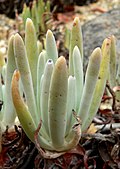Top Qs
Timeline
Chat
Perspective
Dudleya virens
Species of succulent From Wikipedia, the free encyclopedia
Remove ads
Dudleya virens, the green liveforever or bright green dudleya, is an uncommon species of perennial, succulent plant in the family Crassulaceae, native to several coastal southern California and Baja California locations.[2]


Remove ads
Distribution
The succulent is found growing in the Palos Verdes Hills on the Palos Verdes Peninsula coast in Los Angeles County; on several of the Channel Islands in California; and on Guadalupe Island off the northwestern Baja California Peninsula, Mexico.
Description
Summarize
Perspective
Dudleya virens leaves are fleshy and strap-shaped, 8–20 cm long and 1.5–3 cm broad, tapering from the base (or from near middle) and are mostly green. They are arranged in a rosette.
The flowers are white, with five petals 7–10 mm long. They are produced in April, May, and June. Hummingbirds visit the flowers for their nectar.
Subspecies
There has been some developing arguments on how to best categorize the various subspecies of Dudleya virens. The division stems from the fact that the current groupings of the Dudleya virens subspecies are polyphyletic as opposed to monophyletic.[16] The overall evolutionary history of Dudleya virens has been difficult to pin down[17] which has contributed to the confusion surrounding the clarification of the subspecies. This has led to some researchers suggesting that the white leafed sub species of should be separated into its own species that is distinct from the green colored subspecies, although this theory is not backed with any DNA results.[16]
Remove ads
Cultivation
Dudleya virens is cultivated as an ornamental plant in the specialty native plants and succulents horticulture trade.[18] It is used in containers, drought tolerant landscapes, and habitat gardens. It prefers well-draining soil, and grows best in full sun or light shade.
Endangerment and Conservation
Summarize
Perspective
Poaching and predation
Dudleya virens has been specifically affected by the surge in Dudleya poaching to be sold in a similar way to Dudleya farinosa which was covered in the 2021 documentary "Plant Heist"[19]. Where Dudleya virens plants are illegally harvested and shipped to regions of Asia to be sold for profit as medicine or as a pot plant.[19] The succulent is also threatened by invasive grazing animal species that were introduced during the colonization of the Americas.[4] These animals over consume the plants.[4] The poaching[19] by people and predation[4] by invasive species has led to Dudleya virens, specifically Dudleya virens spp. insularis, to be ranked a 1B.2 in terms of rarity (rare, threatened, or endangered) by the state of California.[20]
Conservation
Through consorted conservation efforts, Dudleya virens has been able to make a considerable ecological come back from its previously concerning status.[4] One of the major factors in their successful rehabilitation has been the removal of invasive grazing species: rabbits, horse, and pigs that were introduced during the colonization of California. These animals tend to over consume several Dudleya virens subspecies throughout the Channel Islands.[4] The other major factor is that California passed a bill that makes poaching Dudleya virens with an intent to sell a fineable offense[19][20]. The removal of these invasive grazers and the crackdown on succulent poaching[19][4][20] has created the conditions necessary for Dudleya virens to recover across the Channel Islands.[4]
Remove ads
References
External links
Wikiwand - on
Seamless Wikipedia browsing. On steroids.
Remove ads




